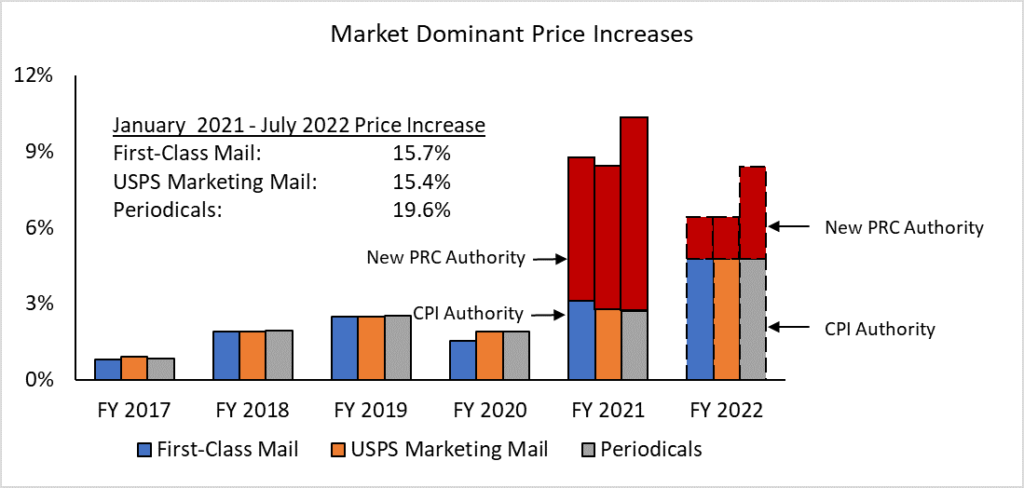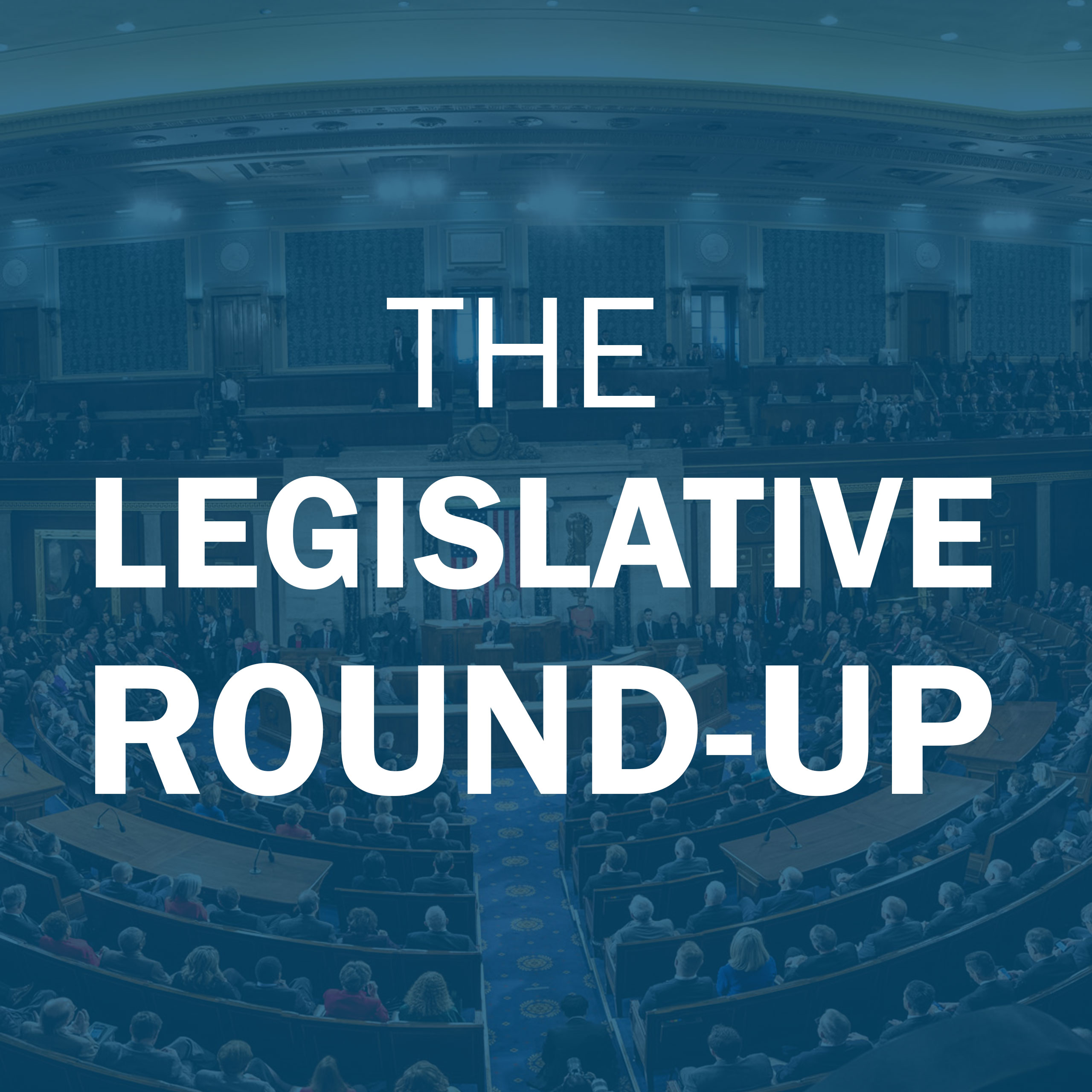Nonprofit Mailers Must Brace for Big Postage Increases in July
Rate Increases Use Every Fraction of a Cent the Law Allows
The Postal Service will raise postal rates another 6.4% to 8.4% (depending on the class of mail) this coming July. It’s little consolation but at least mailers can plan for the jolt.
These hefty increases were made possible when the Postal Regulatory Commission (PRC) granted the USPS a new rate authority in late 2020. The authority is an add-on to the previous system which permitted increases only up to a ceiling determined by the annual consumer price index (CPI), a measure of inflation.
The consequence is accumulated increases between 15.7 and 19.6% in a mere 18-month period (see the chart below). This can only be a severe shock to the system of any kind of mailer, and particularly so considering how stretched many nonprofits have been coping with the demands of the pandemic
 Image Credit: Alliance of Nonprofit Mailers, Stephen Kearney, steve@nonprofitmailers.org
Image Credit: Alliance of Nonprofit Mailers, Stephen Kearney, steve@nonprofitmailers.org
The situation can only get worse if the status quo persists. USPS will enjoy this new add-on authority for another 3-4 years. When it has run its course, nonprofit mailers will have absorbed increases of 50-60% from start to finish.
In TNPA’s view, the rate add-on orchestrated by the PRC is not a solution to the Postal Service’s financial woes. Rather it is a symptom of them. Without substantial structural reform, there is not much hope the woes will do anything but get worse. So nonprofits, along with all other users of the mail, must seek legislative solutions from Congress. We, in collaboration with other mailer organizations have begun that process. It will be a long one.
Why this is so important to nonprofits
The mail is a vital conduit for the nonprofit community. It has outsized importance to us. Commercial mailers typically have numerous options for reaching their customers and potential customers. Nonprofits typically do not have the same array of options.
A compelling letter with a personal message sent via the mail has been, and continues to be, an effective means of communication from nonprofits to donors, members, beneficiaries, and the general public. Contrary to popular views presuming email and web sites can carry the day, mail remains a centerpiece of successful fundraising and communication programs.
With postage rising at a rate substantially higher than the rate of inflation, it’s no wonder many nonprofits are extremely concerned. We should be!
How we got here
The enactment of the landmark Postal Accountability and Enhancement Act of 2006 (PAEA), mailers were placed in the enviable position of near certainty as to the timing and amount of rate increases. This was unprecedented from the advent of the Postal Service in 1971.
Specifically, the PAEA limited price increases to a set-by-law formula derived from the Consumer Price Index. Therefore, since 2006 (aside from a bump due to the Great Recession), each January postal rates increased approximately at the rate of inflation, predictable as to both amount and timing. Thanks to the Postal Regulatory Commission (PRC) those days are over!
Under the 2006 law, the PRC was given the task of conducting a ten-year review of the law’s effectiveness. The PRC concluded USPS’s poor financial situation was due to the CPI cap (as opposed to, say, a lack of increased operational efficiency or control of costs). It therefore proposed a new formula, adopted in December 2020, which gave new ratemaking authority to USPS, permitting variable surcharges to be added to the CPI.
In addition, USPS chose to exacerbate mailers’ challenges by splitting the allowable annual increases into two per year rate changes, presumably to squeeze out a few extra dollars of revenue, Mailers now face a new, much more challenging environment of substantially larger rate increases imposed twice a year, year in and year out.
What can we do now?
Collectively, mailers took a logical first step. A coalition of mailers’ association sued the PRC in late 2020 asserting that it did not have the authority to authorize raising rates above the PAEA’s CPI cap. TNPA contributed to the effort.
On November 12, 2021, the U.S. Court of Appeals (D.C. Circuit) ruled against the suit filed by the mailers. The Court ruled PRC acted within its authority, giving a big win to USPS (also a party to the lawsuit).
With that disappointing decision, now it’s all about Capitol Hill. Before the bad news in November, TNPA had begun reaching out to key players in the Senate (usually the ultimate decider in major reforms, especially in the postal arena). We were exploring options in the event the lawsuit went against us. What we learned was not encouraging.
Very few Senators had an appetite for wading into postal issues, historically always a quagmire. Moreover, H.R. 3076 (labeled the Postal Service Reform Act of 2121) was then working its way through the House (It passed the House on February 8). So a Senator could fairly say, “we’ll wait and see what the House does.”
Given its lukewarm reaction to entreaties from mailers, remedial action in the Senate is very unlikely. The bad news for mailers is quite clear: USPS gets relief from some of its employee-related obligations but the bill does nothing of substance for mailers; that is, the current “add-on” ratemaking system remains undisturbed.
Logically, when the Senate takes up the bill is the legislative moment for mailers to ask for relief. For instance, mailers organizations make the case the Service’s financial situation has changed materially and for the better since the PRC ratemaking. They drafted legislative language which would have frozen rates pending a reconsideration by the PRC of its add-on rule.
The proposal is logical and supported by TNPA. But, as noted above, nothing is likely to get serious consideration, much less make its way to legislation. The bottom line: the Senate is very unlikely to make any material changes to the bill.
Accordingly, the nonprofit sector faces a long-term challenge in addressing the continuing large rate increases. Ideal for the nonprofit sector—and all mailers—would be a return to the original goals of the Postal Reform Act of 2006: predictable rate increases (as to both amount and timing), in line with the rate of inflation.
To that end, TNPA will continue to work closely with other umbrella organizations representing nonprofit mailers. We have also joined an important coalition, Keep US Posted, a group of organizations have joined together to work for a reliable, affordable USPS.
The bottom line
We may or may not be able to fashion some interim relief for mailers. If we along with other mailers do not succeed, it won’t be for lack of trying. But TNPA strongly believes a long-term solution to endlessly skyrocketing rates can only be found by way of structural reform of the Postal Service and of its funding methods. Stated simply, an organization cannot successfully be “run as a business” while incorporating substantial, and obligatory, public service missions in its operations.



